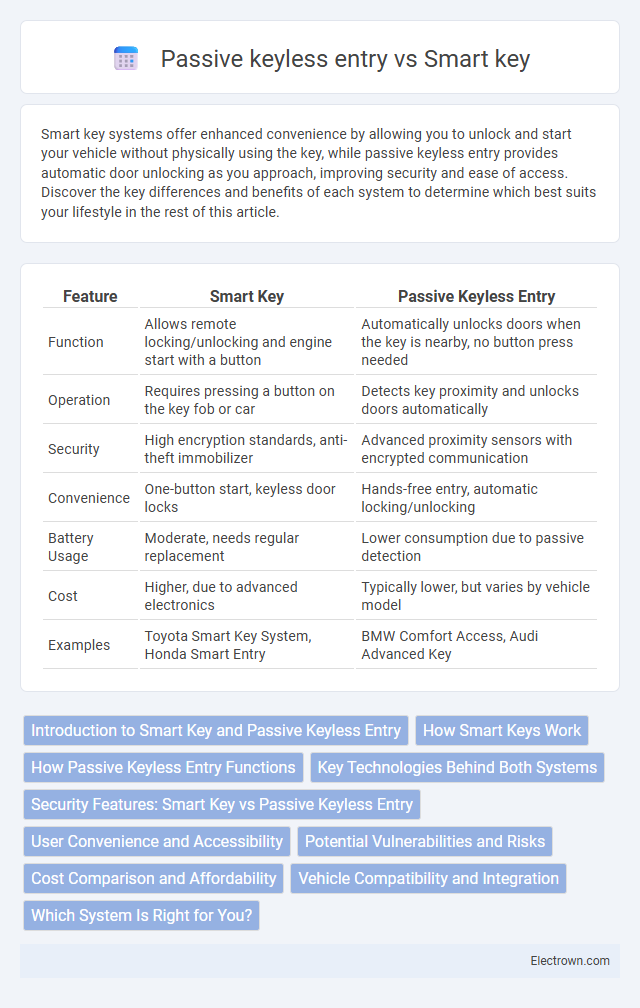Smart key systems offer enhanced convenience by allowing you to unlock and start your vehicle without physically using the key, while passive keyless entry provides automatic door unlocking as you approach, improving security and ease of access. Discover the key differences and benefits of each system to determine which best suits your lifestyle in the rest of this article.
Table of Comparison
| Feature | Smart Key | Passive Keyless Entry |
|---|---|---|
| Function | Allows remote locking/unlocking and engine start with a button | Automatically unlocks doors when the key is nearby, no button press needed |
| Operation | Requires pressing a button on the key fob or car | Detects key proximity and unlocks doors automatically |
| Security | High encryption standards, anti-theft immobilizer | Advanced proximity sensors with encrypted communication |
| Convenience | One-button start, keyless door locks | Hands-free entry, automatic locking/unlocking |
| Battery Usage | Moderate, needs regular replacement | Lower consumption due to passive detection |
| Cost | Higher, due to advanced electronics | Typically lower, but varies by vehicle model |
| Examples | Toyota Smart Key System, Honda Smart Entry | BMW Comfort Access, Audi Advanced Key |
Introduction to Smart Key and Passive Keyless Entry
Smart key and passive keyless entry systems enhance vehicle access by using wireless technology to unlock and start cars without physically inserting a key. Smart key requires pressing a button on the fob to unlock or start the vehicle, while passive keyless entry unlocks the car automatically when the key fob is in close proximity. These systems increase convenience and security by eliminating the need for manual key handling and offering encryption to prevent unauthorized access.
How Smart Keys Work
Smart keys operate through encrypted radio signals that communicate with the vehicle's onboard computer, allowing keyless entry and ignition when the key fob is within proximity. These systems employ rolling codes and signal authentication to prevent unauthorized access or relay attacks. Compared to passive keyless entry, smart keys enhance security by requiring direct user interaction, such as pressing a button on the fob for door unlocking or engine start.
How Passive Keyless Entry Functions
Passive Keyless Entry (PKE) functions by using proximity sensors and encrypted radio signals to automatically detect the presence of an authorized key fob near the vehicle, allowing entry and engine start without physical key interaction. The system communicates with the car's onboard computer to verify authentication, unlocking doors or enabling ignition when the key is within a specific range, typically a few feet. This wireless technology enhances convenience and security by eliminating the need to manually press buttons or insert the key.
Key Technologies Behind Both Systems
Smart key systems use radio frequency identification (RFID) and encrypted communication protocols to authenticate and unlock vehicles without physical key insertion. Passive keyless entry relies on proximity sensors and low-frequency signals to detect the key fob's presence, enabling automatic door unlocking when You approach. Both technologies incorporate advanced microchips and rolling codes to enhance security and prevent unauthorized access.
Security Features: Smart Key vs Passive Keyless Entry
Smart Key systems enhance security by utilizing encrypted communication and proximity sensors that detect authorized devices only within a specific range, reducing the risk of relay attacks. Passive Keyless Entry relies on radio frequency identification (RFID), but its susceptibility to signal amplification or relay hacking poses potential vulnerabilities. Advanced Smart Keys often incorporate rolling codes and motion detection, providing superior protection compared to standard Passive Keyless Entry methods.
User Convenience and Accessibility
Smart key systems enhance user convenience by enabling remote engine start, automatic door unlocking, and personalized settings, allowing seamless vehicle access without physically handling the key. Passive keyless entry offers effortless accessibility through proximity detection, automatically unlocking the car as the user approaches or locking it upon departure, eliminating the need to press buttons. Both technologies prioritize hands-free operation, but smart keys often provide more advanced customization and functionality.
Potential Vulnerabilities and Risks
Smart key systems and passive keyless entry both improve vehicle convenience but face distinct security vulnerabilities and risks. Smart key systems can be susceptible to relay attacks, where thieves intercept and extend the key signal to unlock and start the vehicle remotely. Passive keyless entry increases the risk of signal amplification attacks, which exploit the key fob's continuous communication, allowing unauthorized access without the owner's knowledge.
Cost Comparison and Affordability
Smart key systems generally come with a higher price tag due to advanced encryption and added features like remote start and proximity unlocking, making them less affordable upfront compared to passive keyless entry. Passive keyless entry systems offer a more budget-friendly option by providing basic keyless convenience without the complexity and cost of smart systems. When considering your car's technology upgrade, evaluating long-term value and potential security benefits can help justify investing in a smart key despite its higher initial cost.
Vehicle Compatibility and Integration
Smart key systems offer broad vehicle compatibility with advanced integration features, supporting various car models from luxury to mid-range brands through encrypted wireless communication. Passive keyless entry (PKE) is commonly integrated into newer vehicles, allowing seamless access and ignition without requiring physical key interaction, enhancing convenience and security. Both systems leverage vehicle electronics but smart keys often provide more customizable integration options, such as remote start and personalized driver settings, depending on the vehicle manufacturer.
Which System Is Right for You?
Smart key systems offer seamless, push-button start and automatic locking, ideal for drivers seeking convenience and enhanced security in their vehicles. Passive keyless entry provides the benefit of unlocking doors automatically when you approach, eliminating the need to manually use your key fob, perfect for those prioritizing hands-free access. Evaluating your daily routine and vehicle usage will help determine whether the added features of a smart key or the effortless access of passive keyless entry aligns best with your lifestyle.
Smart key vs Passive keyless entry Infographic

 electrown.com
electrown.com